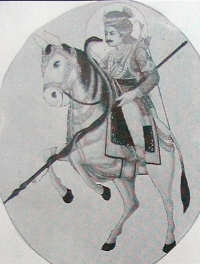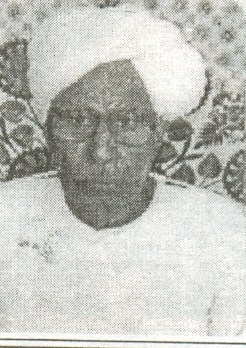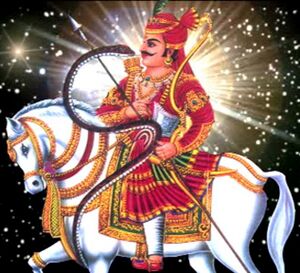Dhaulya
Dhaulya


Dhaulya (धौल्या)[1] [2] Dhauliya (धौलिया)[3] Dholya (धोल्या) Dhavala (धवल)/(धावल),Dholia (ढोलिया)/(धौलिया)[4] [5] Dholia (ढोलिया)[6] Dholiya (ढोलिया)[7] Dholia (धोलिया)[8] is a gotra of Jats found in Rajasthan, Madhya Pradesh and Punjab. Dhaulyas were rulers in Kishangarh and Marwar much before the rule of Rathores. Dhoreliya clan is derived from Dhaulya clan. The towns Dholpur (Rajasthan)[9], Dhule (Maharashtra, Dhauli (Orissa) were probably founded by Dhaulya clan Jats.
Origin
- They are descendants of Shveta Naga (श्वेत नाग) also called Dhaulya Naga (धौल्या नाग) locally.[10] Dhaulya is the Rajasthani version of Shveta (श्वेत) or Dhavala (धवल) in Sanskrit. Some historians consider this gotra of Jats to be originated from province named Dhaul (धौल) of Nagavansh. [11]
- Dholia (ढोलिया) gotra gets name from Place called Dhundhad (ढुंढाड़). [12]
धौलिया गोत्र जयपुर और टोंक जिले के जठुनदल्या जाटों की तड़ में आती है, इस तड़ की सबसे बड़ी गोत्र होने के कारण जठुनदल्या जाटों को जयपुर और टोंक जिले में धौल्या जाट भी कहा जाता है ।
History of Dhaulya clan
Ancestors of Dhaulyas: The most prominent Dhaulya ruler in the memory of people was Tejaji (1074- 1103), who was born in the 21st generation of Dhalya dynasty epi-person Mahabala. If we take period of one generation to be 25 years then the period of Mahabala comes around 550 AD. This was around the end of Gupta Empire. The Gupta Empire was one of the largest political and military empires in ancient India. It was ruled by the Gupta dynasty from around 240 to 550 CE and covered most of northern India and what is now eastern Pakistan and Bangladesh. During this period it was considered a Great power. Historians consider Guptas to be Dharan Jats. The period of this Jat Empire is considered to be the Golden period in the History of India. Mahabala, the primeval man of Dhalya clan ancestry was probably a feudatory of Guptas in the eastern part around Kalinga. This fact get strength from the existence of Dhauli (धोली) hills located on the banks of the river Daya, 8 km south of Bhubaneswar in Orissa. Dhaulya clan of Jats probably gave name to the hill Dhauli.[13] It is a hill with vast open space adjoining it, and has major Edicts of Ashoka engraved on a mass of rock, by the side of the road leading to the summit of the hill. Dhauli hill is presumed to be the area where Kalinga War was fought. The Dhavaleswar temple is one of the larger temples in Dhauli. According to Dr Naval Viyogi remains of their offshoot, the royal family of Dhavaladeva is still existing at Dalbhumigarh near Kharagpur in Orissa. [14]
Dhavala ruler in Pali:
We find mention of a king named Dhavala in the branch of Hastikundi Chauhans. Hastikundi Inscription of V.S. 1053 (24 January 997 AD) was found at Beejapur village in Bali Tahsil of Pali district in Rajasthan. Its language is Sanskrit and script is similar to Harsha Inscription of 961 AD. It mentions the achievements of king Dhavala, who provided shelter to the armies of Chalukya King Mularaja and also Mahendra and Dharanivaraha against the enemies.[15]
Dhulia rulers in Haryana:
There is mention of Dhulia rulers by Ram Swarup Joon in Badli area of Haryana. Badra Sen was an officer in the army of Prithvi Raj. Badli Pargana was his estate. He belonged to a Dhulia family of Indergarh. Before the Chauhan rule, Bhadra, Ajmer, Indergarh etc. were the capitals of the Gor Jats. After the death of Prithvi Raj there was chaos in the country. The Khokhar Jats slayed Mohammad Ghori near Multan. There was a woman named Bodli. The village was named Badli in her honour. Sant Sarang Dev's samadhi (shrine) still exists in Badli and is widely worshipped.
Dhaulya rulers in Nagaur:
The Dhaulya clan ancestors of Tejaji (1074- 1103) were settled in Khilchipur in Madhya Pradesh. The Naga Jats of Marwar are from Vasuki or Ganapati Nagavansh. The Dhaulya clan started after Dhawal Rao or Dhaula Rao ruler of Nagavansh. Swet Naga in Sanskrit is the Dhaulya Naga in prakrit language. Tejaji's ancestor Udairaj (930 AD) occupied Kharnal area in Marwar and made it his capital. There were twenty four villages in Khirnal pargana and area was quite extensive. This pargana of Khirnal was very famous during those days.[16]
डॉ पेमाराम[17]लिखते हैं कि सिंध और पंजाब से समय-समय पर ज्यों-ज्यों जाट राजस्थान में आते गये, मरूस्थलीय प्रदेशों में बसने के साथ ही उन्होने प्रजातन्त्रीय तरीके से अपने छोटे-छोटे गणराज्य बना लिये थे जो अपनी सुरक्षा की व्यवस्था स्वयं करते थे तथा मिल-बैठकर अपने आपसी विवाद सुलझा लेते थे । ऐसे गणराज्य तीसरी सदी से लेकर सोलहवीं सदी तक चलते रहे । जैसे ईसा की तीसरी शताब्दी तक यौधेयों का जांगल प्रदेश पर अधिकार था । उसके बाद नागों ने उन्हें हरा कर जांगल प्रदेश (वर्तमान बिकानेर एवं नागौर जिला) पर अधिकार कर लिया । यौधेयों को हराने वाले पद्मावती के भारशिव नाग थे, जिन्होने चौथी शताब्दी से लेकर छठी शताब्दी तक बिकानेर, नागौर, जोधपुर तथा जालोर के जसवन्तपुरा तक शासन किया । जांगल प्रदेश में नागों के अधीन जो क्षेत्र था, उसकी राजधानी अहिच्छत्रपुर (नागौर) थी । यही वजह है कि नागौर के आस-पास चारों ओर अनेक नागवंशी मिसलों के नाम पर अनेक गांव बसे हुये हैं जैसे काला मिसल के नाम पर काल्यास, फ़िरड़ोदा का फिड़ोद, इनाणियां का इनाणा, भाकल का भाखरोद, बानों का भदाणा, भरणा का भरणगांव / भरनांवा / भरनाई, गोरा का डेह तथा धोला का खड़नाल आदि ।
छठी शताब्दी बाद नागौर पर दौसौ साल तक गूजरों ने राज किया परन्तु आठवीं शताब्दी बाद पुनः काला नागों ने गूजरों को हराकर अपना आधिपत्य कायम किया ।
दसवीं सदी के अन्त में प्रतिहारों ने नागों से नागौर छीन लिया । इस समय प्रतिहारों ने काला नागों का पूर्णतया सफ़ाया कर दिया । थोड़े से नाग बचे वे बलाया गांव में बसे और फिर वहां से अन्यत्र गये ।
Genealogy of Dhaulya rulers
Mansukh Ranwa[18] has provided the Genealogy of Dhaulya rulers. The primeval man of their ancestry was Mahābal, whose descendants and estimated periods calculated @ 30 years for each generation are as under:
- 1. Mahābal (महाबल) (480 AD)
- 2. Bhīmsen (भीमसेन) (510 AD)
- 3. Pīlapunjar (पीलपंजर) (540 AD)
- 4. Sārangdev (सारंगदेव) (570 AD)
- 5. Shaktipāl (शक्तिपाल) (600 AD)
- 6. Rāypāl (रायपाल) (630 AD)
- 7. Dhawalpāl (धवलपाल) (660 AD)
- 8. Nayanpāl (नयनपाल) (690 AD)
- 9. Gharṣanpāl (घर्षणपाल) (720 AD)
- 10. Takkapāl (तक्कपाल) (750 AD)
- 11. Mūlsen (मूलसेन) (780 AD)
- 12. Ratansen (रतनसेण ) (810 AD)
- 13. Śuṇḍal (सुण्डल) (840 AD)
- 14. Kuṇḍal (870 AD)
- 15. Pippal (पिप्पल) (900 AD)
- 16. Udayarāj (उदयराज) (930 AD) (Udayaraja Dhaulya defeated Kala Jats of Jayal and occupied Kharnal in 964 AD and made his capital)[19]
- 17. Narpāl (नरपाल) (960 AD)
- 18. Kāmrāj (कामराज) (990 AD)
- 19. Vohitrāj (वोहितराज) (1020 AD)
- 20. Thirarāj (थिरराज) (1050 AD) or Tahadev (ताहड़देव)
- 21. Tejpal (तेजपाल) (1074- 1103 AD)
Sant Kanha Ram[20] writes that This genealogy is based on Badwa of Dhaulya clan Shri Bhairu Ram Bhat (died: 1996 AD) of Degana. Sanwat Ram Bhat provided names of brothers of Tejaj's father Tahar Dev: 1. Narpal, 2. Jaisi, 3. Dhursi, 4. Budhraj, 5. Askaran and 6. Shersi. Out of them Askaran and Budhraj became Jhunjar, died fighting with enemies. Deoli of Askaran is is situated in the north of village Kharnal.
Taharji had six sons namely - Tejaji, Raṇaji, Guṇaji, Maheshji, Nagji, and Rūpji. He had one daughter named Rājal . Rājal was married. Rājal was married to Jogaji Siyag of village Tabījī (तबीजी). Rājal had become sati with his brother Tejaji.
The most prominent Dhaulya Jat - Tejaji
Tejaji (तेजाजी) or Veer Teja (वीर तेजा) (1074- 1103) was a Jat folk-deity who lived in the state of Rajasthan in India. The history of Rajasthan is filled with lots of heroic stories and instances where people have put their life and families at risk and kept the pride and values like loyalty, freedom, truth, shelter,social reform etc intact. Veer Teja was one of these famous people in the history of Rajasthan.
Birth of Tejaji
Tejaji is considered to be folk-deity and worshiped in entire Rajasthan, Uttar Pradesh, and Madhya Pradesh by all communities. Tejaji as a historical person was was born on Bhadrapad Shukla Dashmi, dated 29 January 1074 , in the family of Dhaulya gotra Jats. His father was Chaudhary Taharji (Thirraj), a chieftain of Khirnal (Kharnal) in Nagaur district in Rajasthan. His mother's name was Ramkunwari.
The most renowned person in Dhaulya gotra was Tejaji or Veer Teja. He was born in 1074. Rajasthan was ruled at that time by small states, headed by various chieftains. Tejaji's father was Taharji who was chieftain of Khirnal. His rule extended from Khirnal to Roopnagar. Their neighbouring state was that of Nagas. Nagas had been eradicated from Nagaur. Gujars were rejected in Bhinmal. Meenas were rulers in various parts of Jaipur. Tejaji was married in Paner, which was situated on the banks of Paner River in Jaipur region.

तेजाजी के पूर्वज
संत श्री कान्हाराम[21] ने लिखा है कि.... [पृष्ठ-62] : रामायण काल में तेजाजी के पूर्वज मध्यभारत के खिलचीपुर के क्षेत्र में रहते थे। कहते हैं कि जब राम वनवास पर थे तब लक्ष्मण ने तेजाजी के पूर्वजों के खेत से तिल खाये थे। बाद में राजनैतिक कारणों से तेजाजी के पूर्वज खिलचीपुर छोडकर पहले गोहद आए वहाँ से धौलपुर आए थे। तेजाजी के वंश में सातवीं पीढ़ी में तथा तेजाजी से पहले 15वीं पीढ़ी में धवल पाल हुये थे। उन्हीं के नाम पर धौलिया गोत्र चला। श्वेतनाग ही धोलानाग थे। धोलपुर में भाईयों की आपसी लड़ाई के कारण धोलपुर छोडकर नागाणा के जायल क्षेत्र में आ बसे।
[पृष्ठ-63]: तेजाजी के छठी पीढ़ी पहले के पूर्वज उदयराज का जायलों के साथ युद्ध हो गया, जिसमें उदयराज की जीत तथा जायलों की हार हुई। युद्ध से उपजे इस बैर के कारण जायल वाले आज भी तेजाजी के प्रति दुर्भावना रखते हैं। फिर वे जायल से जोधपुर-नागौर की सीमा स्थित धौली डेह (करणु के पास) में जाकर बस गए। धौलिया गोत्र के कारण उस डेह (पानी का आश्रय) का नाम धौली डेह पड़ा। यह घटना विक्रम संवत 1021 (964 ई.) के पहले की है। विक्रम संवत 1021 (964 ई.) में उदयराज ने खरनाल पर अधिकार कर लिया और इसे अपनी राजधानी बनाया। 24 गांवों के खरनाल गणराज्य का क्षेत्रफल काफी विस्तृत था। तब खरनाल का नाम करनाल था, जो उच्चारण भेद के कारण खरनाल हो गया। उपर्युक्त मध्य भारत खिलचीपुर, गोहाद, धौलपुर, नागाणा, जायल, धौली डेह, खरनाल आदि से संबन्धित सम्पूर्ण तथ्य प्राचीन इतिहास में विद्यमान होने के साथ ही डेगाना निवासी धौलिया गोत्र के बही-भाट श्री भैरूराम भाट की पौथी में भी लिखे हुये हैं।
Dhaulya Bhat
- Dhaulya : Bhat - Bharu Ram Bhat, From Degana, Nagaur keeps records of Dhaulya clan. Meghraj Hansraj, Naresh Kumar Govind Raj Haridwar (Record from VS 1806) Earlier Record at Sauron Ghat.
Distribution in Rajasthan
Villages in Barmer district
Setrau (सेतराऊ),
Villages in Bikaner district
Villages in Alwar district
Villages in Ajmer district
Villages in Jaipur district
Chandma Kalan (3), Dosra (4), Jatwara Jaipur, Jharana, Kareda Khurd (2), Maadi (7), Nadha Madhorajpura (3), Nathmalpura (8), Nayagaon Fagi (6), Parwan (5), Gothra
Villages in Nagaur district
Badgaon, Dehroo, Dholiader, Dhundhiyari, Ganthia, Gowa Kalan, Gunpaliya, Indawar, Kharnal (150), Leeliya, Dholiader, Dhundhiyari, Gunpaliya, Phalki,
Villages in Jodhpur district
Villages in Baran district
Villages in Bhilwara district
Villages in Kota district
Locations in Jaipur city
Barkat Nagar, Sanganer,
Villages in Tonk district
Abhaypura Niwai, Babdi Darda, Balapura Tonk, Bhagwanpura (6), Bhairupura (2), Bharni Tonk (1), Bhurali (1), Borkhandi (1), Darda Hind, Deoganj, Dodwadi (1), Gopalpura (11), Harbhagatpura, Jankipura, Kadila (6), Kalyanpura Bonrkhandi (6), Khidki (2), Kumharia (1), Lawadar, Loharwada (22), Mungoda (1), Nalaa, Nohta, Palai (8), Ramnagar Aliyari (3), Sedari, Sendiyawas , Shergarh (12), Thanwala,
Villages in Sawai Madhopur district
Distribution in Madhya Pradesh
Villages in Dhar district
Badwai, Kherwas, Padunya, Talwada (Dhar),
Villages in Harda district
Harda Khurd, (Harda) Chhipaner, Gondagaon Kalan,
Villages in Indore District
Betma, Dhureri, Mukata, Pardeshipura, Sendal, Simrod,
Villages in Nimach district
Villages in Rajgarh district
Villages in Ratlam district
Villages in Ratlam district with population of this gotra are:
Delanpur (1), Dodiana (1), Hanumanpalia (1), Mundari (2), Dantodia (1), Salakhedi (1),
Villages in Shajapur district
Villages in Ujjain district
Villages in Mandsaur district
Distribution in Gujarat
Villages in Banas Kantha district
Bhachalva, Chidivadu, Javal, Kumar, Pamaru, Tetoda, Theravada,
Distribution in Punjab
Villages in Hoshiarpur district
Dholia is village in Dasua tahsil in Hoshiarpur district in Punjab.
Notable persons
- Tejaji (1074- 1103) - folk-deity in Rajasthan.
- Ramniwas Choudhary (Dholya)- RHJS (retd) Judge, VPO: Mandi, Fagi tahsil in Jaipur district in Rajasthan.
- Nagendra Choudhary (Dholya)- Magistrate (Kota city), VPO: Mandi, Fagi tahsil in Jaipur district in Rajasthan.
- Ramlal Jat (Dholya)- AAO AG (Audit), Date of Birth- 1-December,1968, -Jankipura, PO-Kalmanda, Teh-Malpura,District-Tonk Present address- P-18, Phool Colony, Choudhary Petrol Pump,Sanganer,Jaipur, Mob no-9414719413
See also
- Tejaji - Folk-deity from this gotra
Gallery
-
Portrait of Jat Chief Shri Nagauri Kalam of Dhaulya clan. Nagaur(?), circa 1760-70. The inscription above the painting reads : shri jat sardar nagauri kalam dholya bans ka (Jat leader, Nagauri kalam of Dholya clan ). Source - Jat Kshatriya Culture
References
- ↑ Jat History Dalip Singh Ahlawat/Parishisht-I, s.n. ध-36
- ↑ O.S.Tugania:Jat Samuday ke Pramukh Adhar Bindu,p.46,s.n. 1351
- ↑ O.S.Tugania:Jat Samuday ke Pramukh Adhar Bindu,p.46,s.n. 1351
- ↑ Jat History Dalip Singh Ahlawat/Parishisht-I, s.n. ध-58
- ↑ O.S.Tugania:Jat Samuday ke Pramukh Adhar Bindu,p.46,s.n. 1326
- ↑ Jat History Dalip Singh Ahlawat/Parishisht-I, s.n. 10
- ↑ O.S.Tugania:Jat Samuday ke Pramukh Adhar Bindu,p.42,s.n. 1093
- ↑ Jat History Thakur Deshraj/Chapter IX,p.695
- ↑ जाट इतिहास:ठाकुर देशराज,पृ.684
- ↑ Dr Pema Ram:Rajasthan Ke Jaton Ka Itihas, p.19
- ↑ Mahendra Singh Arya et al.: Ādhunik Jat Itihas, p.258
- ↑ Dr Mahendra Singh Arya etc,: Ādhunik Jat Itihas, p. 251
- ↑ Mahendra Singh Arya et al.: Ādhunik Jat Itihas, p.258
- ↑ Dr Naval Viyogi: Nagas – The Ancient Rulers of India, p. 158
- ↑ डॉ गोपीनाथ शर्मा: 'राजस्थान के इतिहास के स्त्रोत', 1983, पृ.68
- ↑ Mansukh Ranwa, Kshatriya Shiromani Veer Tejaji, 2001, p.13
- ↑ राजस्थान के जाटों का इतिहास, 2010, पृ.19
- ↑ Mansukh Ranwa: Kshatriya Shiromani Veer Tejaji, 2001, p.13
- ↑ Sant Kanha Ram:Shri Veer Tejaji Ka Itihas Evam Jiwan Charitra (Shodh Granth), Published by Veer Tejaji Shodh Sansthan Sursura, Ajmer, 2015. pp.62-63
- ↑ Sant Kanha Ram: Shri Veer Tejaji Ka Itihas Evam Jiwan Charitra (Shodh Granth), Published by Veer Tejaji Shodh Sansthan Sursura, Ajmer, 2015. p.157
- ↑ Sant Kanha Ram: Shri Veer Tejaji Ka Itihas Evam Jiwan Charitra (Shodh Granth), Published by Veer Tejaji Shodh Sansthan Sursura, Ajmer, 2015. pp.62-63
Further reading
- Thakur Deshraj: Jat Itihas (Hindi), Maharaja Suraj Mal Smarak Shiksha Sansthan, Delhi, 1934.
- Jat Samaj, Agra - November 2000
Back to Jat Gotras
- Jat Gotras
- Gotras after Places
- Gujarat
- Gotras in Banas Kantha
- Madhya Pradesh
- Gotras in Dhar
- Gotras in Ujjain
- Gotras in Harda
- Gotras in Rajgarh
- Gotras in Nimach
- Gotras in Mandsaur
- Rajasthan
- Gotras in Barmer
- Gotras in Bikaner
- Gotras in Nagaur
- Gotras in Bhilwara
- Gotras in Jodhpur
- Gotras in Jaipur
- Gotras in Sawai Madhopur
- Gotras in Tonk
- Gotras in Ratlam
- Gotras in Baran
- Gotras in Kota
- Ancient Jat Gotras
- Nagavanshi
- Genealogy
- Bard History


